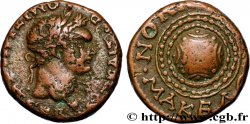v27_0523 - DOMIZIANO Denier
MONNAIES 27 (2006)
起拍价 : 350.00 €
估价 : 550.00 €
未售出的物品
起拍价 : 350.00 €
估价 : 550.00 €
未售出的物品
种类 Denier
日期: 79
铸币厂名称/城市 Roma
材质 silver
纯度、成色(用角密度) 900 ‰
直径 19 mm
模子方针 6 h.
重量 3,41 g.
稀少度 R1
关于品相的说明
Bel exemplaire parfaitement centré au droit. Usure régulière. Fine patine grise
出版目录中的项代码 :
正面
正面的文字 CAESAR AVG F DOMITINANVS COS VI.
正面的说明书 Tête laurée de Domitien à droite (O*).
正面的翻译 “Cæsar Augusti Filius Domitianus Consul sextum”, (César fils d’auguste Domitien consul pour la sixième fois).
背面
背面的文字 PRINCEPS - IVVENTVTIS.
背面的说明书 Deux mains jointes avec une aigle légionnaire (aquila) posée sur une proue de navire.
背面的翻译 “Princeps Iuventutis”, (Prince de la jeunesse).
评论
Ce revers représente une enseigne très particulière qui pourrait avoir un rapport avec des navires d’observation, “Speculatoria navigia”, (César 4, 26), cités aussi par Tite-Live. Il est très proche du denier de Marc Antoine (RCV 1484), où seules les deux mains jointes diffèrent. Ou, plus simplement, il peut être un appel à la loyauté de l’armée pour reconnaitre les nouveaux princes, comme le fera quelques années plus tard Nerva avec un denier présentant exactement le même revers, à la légende “CONCORDIA EXERCITVM” (RCV 3020). Ce type sera repris sous Titus, avec la mention du septième consulat de Domitien césar (cf. RCV. 2673).
This reverse represents a very particular ensign that could be related to observation ships, “Speculatoria navigia”, (Caesar 4, 26), also mentioned by Livy. It is very close to the denarius of Mark Antony (RCV 1484), where only the two joined hands differ. Or, more simply, it could be a call for loyalty from the army to recognize the new princes, as Nerva would do a few years later with a denarius with exactly the same reverse, with the legend “CONCORDIA EXERCITVM” (RCV 3020). This type will be taken up again under Titus, with the mention of the seventh consulate of Domitian Caesar (cf. RCV. 2673)
This reverse represents a very particular ensign that could be related to observation ships, “Speculatoria navigia”, (Caesar 4, 26), also mentioned by Livy. It is very close to the denarius of Mark Antony (RCV 1484), where only the two joined hands differ. Or, more simply, it could be a call for loyalty from the army to recognize the new princes, as Nerva would do a few years later with a denarius with exactly the same reverse, with the legend “CONCORDIA EXERCITVM” (RCV 3020). This type will be taken up again under Titus, with the mention of the seventh consulate of Domitian Caesar (cf. RCV. 2673)








 对产品描述纠错
对产品描述纠错 打印
打印 分享我的选择
分享我的选择 提问
提问 Consign / sell
Consign / sell
 产品介绍
产品介绍










